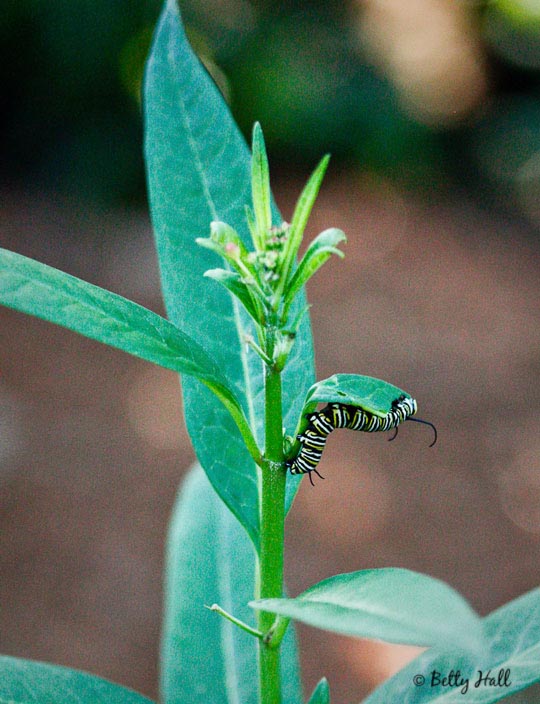Oh, happy day! Early last Thursday morning I checked the garden and was thrilled to discover a beautiful Monarch caterpillar (Danaus plexippus) on my annual Tropical Milkweed (Asclepias curassavica).

This is the first time I’ve grown Tropical Milkweed, also known as Bloodflower, and I’m delighted to know the Monarchs like it. It’s a tall slender plant and has been easy to fit among my other garden plants. It also has a beautiful blossom.

I’ve checked the North American Butterfly Association website and the more I read about this plant the more I’m impressed. It’s not native to the U.S. but is grown in a wide range, does not seem invasive, and attracts Monarchs. Sounds good to me. If you’ve grown Tropical Milkweed, I’d be glad to know your experience.
P.S. I realize this is short notice but I’ll be doing a presentation on Raising and Attracting Butterflies, at the Lexington Arboretum on Tuesday, July 19th, 10 a.m.- noon. I’d be glad to have you join us.
Update/Caution: I had a scary experience after cutting Tropical Milkweed for some Monarch caterpillars. Apparently I got some of the sap in my eyes, and by the next morning I could barely see. Read the full saga. If you are working with any milkweed plants, be careful to keep the sap away from your eyes and wash your hands thoroughly when you’re done.


Betty, I grew & sold through my business WildLifeScapes this variety of Asclepias…it’s a magnet for Monarchs. When we lived outside of Houston it nurtured hundreds of Monarchs. One Spring wave over 75 caterpillars were hatched, of course, we had to find more! I did not find it to invasive. The aphids love it never bothering other plants in my gardens.
Ellen, it’s encouraging to hear of your experience. Thanks for sharing.
I have grown that kind of milkweed, but it was an annual – I got the seeds from Bakers Heirloom Seed, they called it “Sunset Flower.” I’ve also grown a variety that is all yellow, and it attracted lots of butterflies, too – but it seemed to bloom later in the season. I didn’t get my seeds for these two plants sown early enough in the season this year, so I just went to Shooting Star to get some common milkweed plants, and there are some caterpillars that found the three small plants and have pretty much decimated them before I’ve even had a chance to get them in the ground! The caterpillars are black, brown and white and are covered with really spikey hairlike things. Usually I find Monarch caterpillars on my bronze fennel, but I haven’t seen any yet this year . . .
Kathy, thanks for your comment. As to the caterpillars on your milkweed, I’m guessing those are Milkweed Tussock Moth caterpillars. I have a few on my common milkweed. They look to me like they are made out of yarn. As to the caterpillars that you usually get on your Bronze Fennel, I think those are Black Swallowtail caterpillars. They do look a lot like Monarchs but Monarchs can only eat some kind of milkweed. I’ve finally gotten some Black Swallowtail ‘cats’ on my green Fennel. Hope you, too, will be seeing some soon.
You’re right, now that I think of it, they are black swallowtails, not Monarchs. I was going to photograph the Milkweed Tussock caterpillar after work, but when I got home, he had eaten all the leaves on my little plants and was nowhere to be found!
Kathy, hope your milkweed survives and you are welcome to photograph my Milkweed Tussock moths.
Hello Betty–I’m happy you are enjoying the tropical butterfly milkweed. Our plants are beginning to ” leap up”, just as you and Connie predicted. I checked our tropical plants today–no sightings yet. But we have 11 caterpillars on our Smoky Mountain Fennel plants. I think they are Black Swallowtails.
Raynor